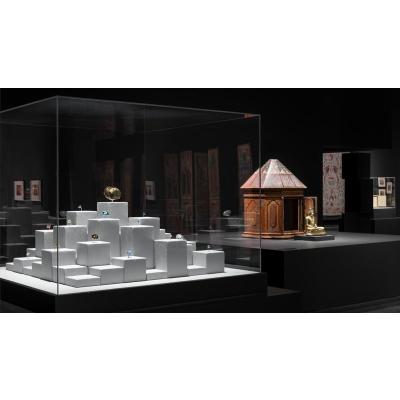
Posted in: Exhibitions
 21 Gemstones open The Jeweled Isle Exhibition. Exhibition view: The Jeweled Isle: Art from Sri Lanka, Los Angeles County Museum of Art (9 December 2018–23 June 2019). Courtesy Los Angeles County Museum of Art. Photo: © Museum Associates/LACMA.
In their ongoing exhibition The Jeweled Isle, the Los Angeles County Museum of Art (LACMA) offers the first comprehensive survey of Sri Lankan art by an American museum. The exhibition remains on view through June 23, 2019. The show opens with a special glass case featuring 21 unmounted precious and semi-precious gemstones, which represent the myriad gemstones mined in Sri Lanka.
21 Gemstones open The Jeweled Isle Exhibition. Exhibition view: The Jeweled Isle: Art from Sri Lanka, Los Angeles County Museum of Art (9 December 2018–23 June 2019). Courtesy Los Angeles County Museum of Art. Photo: © Museum Associates/LACMA.
In their ongoing exhibition The Jeweled Isle, the Los Angeles County Museum of Art (LACMA) offers the first comprehensive survey of Sri Lankan art by an American museum. The exhibition remains on view through June 23, 2019. The show opens with a special glass case featuring 21 unmounted precious and semi-precious gemstones, which represent the myriad gemstones mined in Sri Lanka.
The Jeweled Isle
More than 21 gemstone types are found in Sri Lanka. This is why for millennia the island has been called The Jeweled Isle, or the Island of Gems. Very few regions in the world offer the diversity of gems that Sri Lanka offers. Indeed, the island's jeweled history dates back 2500 years. Positioned just off the southern tip of India, this gorgeous island lies nestled in the India Ocean. Every story about Sri Lanka includes inimitable beauty, jeweled treasure, and rousing adventure. This truly remarkable and unique island offers everything from azure oceanic beauty, romantic feathery palms, to ravishing gemstones. To this day, Sri Lanka remains an important hub for gem trading. Among the types of gemstones found on the island, sapphires remain the most important.Ceylon Sapphires
Perhaps the most famous of Ceylon's sapphires is the Ceylon Blue. Gorgeous with its blue cornflower color, the Ceylon Blue radiates magnificently without any enhancements or treatments. Ceylon sapphires also form in a rainbow of other colors, including pastel shades of pink, yellow, and lavender. They also form in jewel tones like green, orange, and purple. In addition, Ceylon boasts the gorgeous padparadscha sapphire which takes its name from the celebrated lotus flower. Finally, Ceylon boasts the precious ruby, the red sapphire coveted around the world. Ceylon is famous for sapphires the world over. However, sapphires represent only one of the numerous gemstone species found on the tropical island.More Than 21 Gemstones
According to several sources, the island produces as many as 32 gemstone varieties. Of these, a handful are rarely used in jewelry. However, all of them remain part of the vast jeweled offerings the island has to offer. Here is a comprehensive list of gemstones found on the island: Alexandrite, Amethyst, Aquamarine, Axinite, Beryl, Cassiterite, Chrysoberyl (including Cat's Eye Chrysoberyl), Citrine, Enstatite, Garnet, Hessonite, Iolite, Kornerupine, Moonstone, Oligoclase, Pearl, Peridot, Phenakite, Quartz, Sapphire (including star sapphires, rubies, and padparadscha sapphires), Scapolite, Sillimanite, Spessartine, Spinel, Taaffeite, Topaz, Tourmaline, and Zircon. This list remains staggering in its scope. Just how did all these gemstones wind up on one island anyway?Supercontinents
Approximately 90% of Sri Lanka rests upon Precambrian high-grade metamorphic rocks. (source) Metamorphism, from which metamorphic rock emerges, is the process by which mountains arise. Likely, you've heard of Pangea, the supercontinent from which our individual continents broke off as a result of tectonic forces. In fact, geologists now surmise that several supercontinents existed before Pangea. Perhaps the most important of these is called Gondwanaland. For every supercontinent, there is a series of cataclysmic events that resulted not only in the separation of continents, but also in the provision of heat, chemistry, time, and pressure required for crystals to form. (source) Geologists believe that the destruction of Gondwanaland resulted in the formation of the Mozambique Belt, a band of gemstone-rich earth which extends from Mozambique to Ethiopia and Sudan. Furthermore, this band encompasses the southern tip of India, the islands of Madagascar and Sri Lanka, as well as the east coast of Antarctica. (source) Imagine for a moment the cataclysmic force by which a mountain suddenly emerges from the earth. Tectonic plates slamming into each other with unimaginable force, driving mantle and crust upward toward the sky. As a result, that which once lay buried deep within the earth emerges accessible to the powers of erosion.Gemstone Gravel
Over the course of millions of years, wind, rain, and melt-off smoothed off the rough and craggy surfaces of these mountains. Throughout the centuries, tons of silt, clay, sand, and gravel sluiced down the sides of the mountains, finding their way into the more than 100 rivers found on Sri Lanka. In and alongside these river basins, native Sri Lankans have harvested the earth's bounty in gemstones for the past 2500 years. Even to this day, Sri Lankans practice traditional mining methods which not only serve to preserve the earth, but also employ more than 60,000 miners year-round. In keeping with the long tradition of gemstone mining and trade in Sri Lanka, LACMA chose to open their Jeweled Isle exhibition with this display case featuring 21 unmounted Sri Lankan gemstones. Learn more about this exhibition by clicking here, and plan your visit today! ~Angela Magnotti Andrews5 years ago
5 view(s) 